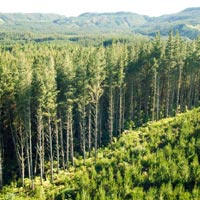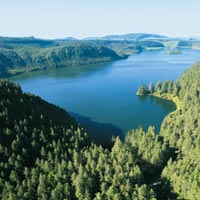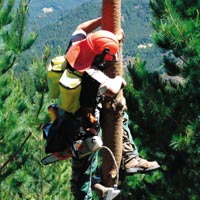The plantation forestry and logging sector directly accounts for 0.6% of GDP or $1,389 billion. This contribution is:
- Greater than the GDP contribution of the sheepmeat and wool sector by over 20%
- About 45% larger than beef sector in GDP terms
- At a similar level of contribution with horticulture
- 0.9% of the total goods producing industries
- Approximately 2.9% of merchandised exports.
The plantation forestry industry’s influence extends well beyond its direct impacts. Forestry and logging are closely intertwined with the rest of the economy and society. This includes jobs, and the incomes it provides, its links to other industries (e.g. transport), the impact it has on rural and urban centres and the environment
$3.8 billion in plantation forestry production value was produced by growing and logging trees nationally in 2015:
- $301 million went on wages and salaries
- $1,100 million went on capital and land
- $2,400 million was spent on inputs (mainly contractor services)
- $171 million was spent on freight to get products to market (not included but dependent on forestry)
Investment by the industry via the Forest Groweres Commodity Levy, ers in research and technology, supported by the NZ government, means plantation forestry is highly innovative. This is reflected in the commitment of the association and its members to the highest standards of sustainable silviculture, environmental practice and workforce safety.
In recent years this has led to be development of codes of practice and standards which have world-leader status. These codes and standards have been adopted by most industry players.
The FOA and NZ Farm Forestry Association (FFA) are the prime industry representatives in the plantation forest growing sector.
The FOA represents the owners of New Zealand's commercial plantation forests. It was set up in 1926 and is now one of the country's most influential primary sector organisations. Its members own or manage around two-thirds of the country's 1.79 million hectares of plantation forests and are responsible for over 70% of the annual harvest.
The NZFFA was formed in 1957. Membership is spread over 27 Branches throughout NZ, and there are 6 special interest groups. NZFFA estimate their members own or manage up to 100,000Ha of forest, and influence the management of a similar area. These forests consist of radiata pine, cypress, eucalypts, redwood, blackwood, other exotic species and managed indigenous forests.
The Forest Grower Levy Trust (FGLT ) is the body responsible for collecting the harvested wood products levy from forest growers. Forest Growers via the FOA and the FFA manage the allocation of levy funds to industry good projects. Final decision and oversight of levy spend is with the FGLT.
Joint committees between FOA and FFA provide opportunities for industry representation and input.
The Forest Industry Safety Council (FISC) is an independent body, substantially funded by the Forest Grower Levy Trust (FGLT).
Close liaison and contact is maintained between other industry bodies such as FICA and Competenz , with representatives attending industry meetings as required.
The Wood Council of NZ (Woodco) brings together the forest growing and forest product processing sectors.

Emissions Trading Scheme FOA has made sure the forest industry view |

FOA Environmental Code of Practice Over a period of three years the Forest Owners Association with input from its members |

FOA Drug and Alcohol Policy The FOA Drug and Alcohol policy was launched |

